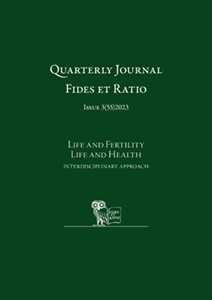Abstract
Abstract: Most women experience at least one or more psychosomatic symptoms before their period, which are characteristic of premenstrual syndrome or premenstrual dysphoric disorder.Aim: This study aimed to investigate whether and to what extent women of childbearing age experience PMS and what is involved.Material and methods: The study was conducted between February and June 2019 at the Medical University of Lublin and the University of Life Sciences in Lublin, and at the Obstetrics and Gynaecology Clinic in Świdnik, among 252 women of reproductive age, aged 20-35. The paper uses the method of diagnostic survey, using its own questionnaire and the Premenstrual Syndrome Scale.Results: About half (45.2%) of the women had moderate severity of symptoms. In contrast, 40.5% of the respondents had no premenstrual syndrome symptoms (0.4%) or only mild symptoms (40.1%). The most common category of symptoms was physical symptoms, including the most common breast tenderness and swelling (52.8%), skin lesions (44%), and cravings for products with added salt and sugar (40.9%). The level of education of the women studied differentiated the perception of PMS symptoms (p = 0.001). The severity of the syndrome was not related to age (p = 0.097), physical activity (p = 0.054), dietary habits (p = 0.650), and vitamin D (p = 0.159) and B (p = 0.458) supplementation.Conclusions: The vast majority of women experience at least one symptom of premenstrual syndrome. Almost half of them have moderate premenstrual symptoms. The most common category of symptoms includes physical symptoms, especially breast tenderness and swelling, skin changes, and cravings for foods with added salt/sugar. Women's level of education makes a difference to their perception of PMS symptoms. The severity of the syndrome does not depend on age, physical activity, dietary habits or vitamin D and B supplementation.Keywords: menstrual cycle, premenstrual syndrome, dysphoric premenstrual disorder
References
Abu Alwafa, R., Badrasawi, M. & Haj Hamad, R. (2021). Prevalence of premenstrual syndrome and its association with psychosocial and lifestyle variables: a cross-sectional study from Palestine. BMC Women’s Health, 21(233). https://doi.org/10.1186/s12905-021-01374-6
Abdi, F., Ozgoli, G. & Rahnemaie, F.S. (2019). A systematic review of the role of vitamin D and calcium in premenstrual syndrome. Obstetrics & Gynecology Science, 62(2), 73-86. https://doi.org/10.5468/ogs.2019.62.2.73
American Psychiatric Association. Diagnostic and Statistical Manual of Mental Disorders, 5th ed. (2013). Washington, DC: American Psychiatric Association Publishing.
Czajkowska, M., Drosdzol-Cop, A., Naworska, B., Galazka, I., Gogola, C., Rutkowska, M., Skrzypulec-Plinta, V. (2020). The impact of competitivesports on menstrualcycle and menstrualdisorders, includingpremenstrualsyndrome, premenstrualdysphoricdisorder and hormonalimbalances. Ginekologia Polska, 91(9), 503-512. https://doi.org/10.5603/GP.2020.0097.
Drosdzol, A., Nowosielski, K., Skrzypulec, V., Plinta, R. (2011). Premenstrualdisorders in Polish adolescent girls: Prevalence and riskfactors. Journal of Obstetrics and GynaecologyResearch, 37(9), 1216-1221. https://doi.org/10.1111/j.1447-0756.2010.01505.x
Fatemi, M., Allahdadian, M., Bahadorani, M. (2019). Comparison of serum level of some trace elements and vitamin D between patients with premenstrual syndrome and normal controls: A cross-sectional study. International Journal of Reproductive Biomedicine, 17(9), 647-652. https://doi.org/10.18502/ijrm.v17i9.5100
Frey Nascimento, A., Gaab, J., Kirsch, I., Kossowsky, J., Meyer, A., Locher, C. (2020). Open-label placebo treatment of women with premenstrual syndrome: study protocol of a randomised controlled trial. British Medical Journal, 10(2), e032868. https://doi.org/10.1136/bmjopen-2019-032868
Itryieva, K. (2022). Premenstrual Syndrome and Premenstrual Dysphoric Disorder in adolescents. Current Problems in Pediatric Adolescent Health Care, 52(5),101187. https://doi.org/10.1016/j.cppeds.2022.101187
Khasanova, D. (2022). Premenstrual Syndrome in the modern science. International Bulletin of Medical Sciences and Clinical Research, 2(12), 16–22.
Kozłowski, P., Kozłowska, M., Kozłowska, K., Cisło M. (2017). The prevalence of premenstrual syndrome in young woman. Journal of Education, Health and Sport, (7), 866-872.
Kwon, Y.J., Sung, D.I. & Lee, J.W. (2022). Association among premenstrual syndrome, dietary patterns, and adherence to mediterranean diet. Nutrients, 14(12), 2460. https://doi.org/10.3390/nu14122460
Molugulu, N., Tumkur, A.N.I.L., Nilugal, K.C. (2016). Study of premenstrual syndrome among future healthcare professionals in Masterskill Global College. Intrnational Journal of Pharmacy and Pharmaceutical Sciences, 8(2), 66-71.
Nappi, R.E. Cucinella L., Bosoni, D., Righi, A., Battista, F., Molinaro, P., Stincardini, G., Piccinino, M., Rossini, R., Tiranini, L. (2022). Premenstrual Syndrome and Premenstrual Dysphoric Disorder as Centrally Based Disorders. Endocrines, 3, 127-138. https://doi.org/10.3390/endocrines3010012
Osborn, E., Wittkowski, A., Brooks, J. Briggs, P.E., Shaughn O’Brien, P.M. (2020). Women’s experiences of receiving a diagnosis of premenstrual dysphoric disorder: a qualitative investigation. Boston Medical Center Women’s Health, 20, 242. https://doi.org/10.1186/s12905-020-01100-8
Padmavathi, P., Sankar, R., Kokilavani, N., Dhanapal, K., AshokB. (2014). Validity and Reliability Study of Premenstrual Syndrome Scale (PMSS), International Journal of Contemporary Management, 2(1), 04-05.
Pałucka, K., Łepecka-Klusek, C., Pilewska-Kozak, A.B., Pawłowska-Muc, A.K., Stadnicka G. (2016). Premenstrual syndrome – myth or reality. Journal of Education, Health and Sport, 6(6): 478-490.
Pokharel, P., Rana, J., Moutchia, J., Uchai, S., Kerri, A., Gutiérrez, P.L. L., Islam, R.M. (2020). Effect of exercise on symptoms of premenstrual syndrome in low and middle-income countries: a protocol for systematic review and meta-analysis, British Medical Journal Open, 10(9), e039274. https://doi.org/10.1136/bmjopen-2020-039274
Retallick-Brown, H., Blampied, N., Rucklidge, J.J. (2020). A Pilot randomized treatment-controlled trial comparing vitamin B6 with broad-spectrum micronutrients for premenstrual syndrome. The Journal Alternative Complementary Medicine, 26, 88–97. https://doi.org/10.1089/acm.2019.0305
Rezende, A.P.R., Alvarenga, F.R., Ramos, M., Franken, D.L., Costa, J.S. D.D., Pattussi, M.P. & Paniz, V.M.V. (2022). Prevalence of premenstrual syndrome and associated factors among academics of a university in midwest Brazil. RevistaBrasileira de Ginecologia e Obstetrícia, 44, 133-141.https://doi.org/10.1055/s-0041-1741456
Ryu, A, Kim, T.H. (2015). Premenstrual syndrome: A mini review. Maturitas, 2015;82(04), 436-440. https://doi.org/10.1016/j.maturitas.2015.08.010
Schroll, J.B., Lauritsen, M.P. (2022). Premenstrual dysphoric disorder: A controversial new diagnosis. Acta Obstetricia and Gynecologica Scandinavica, 101(5), 482-483. https://doi.org/10.1111/aogs.14360
Sieradzy, K., Sieńko, K. Płoch K. (2017). Objawy przedmiesiączkowe u kobiet w wieku 16-35 lat. Położna Nauka i Praktyka, 2, 8-14.
Siminiuc, R., Ţurcanu, D. (2023). Impact of nutritional diet therapy on premenstrual syndrome. Frontiers in Nutrition, 10, 1079417. https://doi.org/10.3389/fnut.2023.1079417
Sut, H.K., Mestogullari, E. (2016). Effect of premenstrual syndrome on work-related quality of life in Turkish nurses. Safety and Health at Work, 7(1), 78-82. https://doi.org/10.1016/j.shaw.2015.09.001
Śliwerski, A., Koszałkowska, K. (2021). The influence of depression on biased diagnosis of premenstrual syndrome and premenstrual dysphoric disorder by the PSST inventory. Life, 11(11),1278. https://doi.org/10.3390/life11111278

